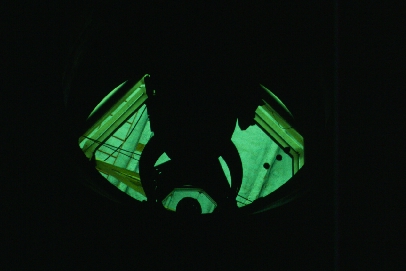

The largest telescope on Mt. Locke proper is the 2.7-meter (formerly 107-inch) Harlan J. Smith telescope, completed in 1968 with substantial support from NASA (thereby ensuring that a fair fraction of time would be available for planetary science). The site also includes the 2.1-meter Struve telescope, the 30- and 36-inch reflectors, and, on adjacent Mt. Fowlkes, the 9.2-meter (or 11-meter, but that's a religious war I have no stake in) Hobby*Eberly Telescope. Mt. Locke only looks like a mountain from the Fort Davis side to the south; the land to the north is higher so it's only a hill from that side. Among these, the 2.7-meter is the largest telescope I know of which uses a solid tube rather than an open framework to support the optical components.
The 107-inch has an unfortunate bit of notoriety in the astronomical community, as the victim of a handgun assault. I haven't been able to track down the dates yet, having been assured by then-Texas grad students that it was before 1976 (with some preference for 1969). Oddly enough, the Sky and Telescope index doesn't show such an item from 1969-1976 (years I happen to have lying around)... Anyway, here's a picture looking down the tube showing the bullet holes in the primary. I'll decline to reveal who let me crawl into the tube to take this picture, though he hasn't worked at McDonald in some years. I show this one in class to make the same point that not seeing a shadow of the secondary mirror for in-focus star images does, but in a more striking way. The three blacked-out areas around the bullet pits appear in the lower right part of the mirror in this view. A Web correspondent points out that there is a brief description of this episode in the epilogues to Big and Bright: A History of the McDonald Observatory by David Evans and J. Derral Mulholland (published by the Univ. of Texas Press in 1986):
Firearms are very common in Texas. Astronomer Brian Warner had his tongue only slightly in cheek when he remarked that "Jeff Davis County is about the size of Israel - and slightly better armed." The prophecy inherent in the aphorism came to pass. The full precipitating causes may never be known, but one February night in 1970 a McDonald Observatory employee (not a Texan, but an Ohioan newly hired from another observatory!) suffered a breakdown and carried a pistol to the observing floor of the 107-inch telescope. He fired a shot at his supervisor, and then unloaded the rest of the clip into the primary mirror. Happily, fused silica is more resilent than ordinary glass, and the big mirror did not break. The craters have been bored out and painted black to reduce any light-scattering effect, and the end result is simply a slight reduction in the efficiency of the telescope. It is now the equivalent of a 106-inch telescope. The incident made the national television news, with Walter Cronkite describing it before a projection showing the wrong telescope upside down.
 |
 |
Currently, the 36-n 82-, and 107-inch telescopes are listed as open for public viewing programs one or more nights a month. In the dark skies of West Texas, that must be really cool. You can explore the area starting with this satellite view from Google Maps.
Last changes: 04/2007 © 2000-2007